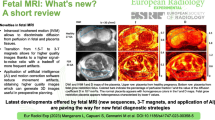Abstract
The purpose of this study was to evaluate the neuroimaging quality and accuracy of prospective real-time navigator-echo acquisition correction versus untriggered intrauterine magnetic resonance imaging (MRI) techniques. Twenty women in whom fetal motion artifacts compromised the neuroimaging quality of fetal MRI taken during the 28.7 ± 4 week of pregnancy below diagnostic levels were additionally investigated using a navigator-triggered half-Fourier acquired single-shot turbo-spin echo (HASTE) sequence. Imaging quality was evaluated by two blinded readers applying a rating scale from 1 (not diagnostic) to 5 (excellent). Diagnostic criteria included depiction of the germinal matrix, grey and white matter, CSF, brain stem and cerebellum. Signal-difference-to-noise ratios (SDNRs) in the white matter and germinal zone were quantitatively evaluated. Imaging quality improved in 18/20 patients using the navigator echo technique (2.4 ± 0.58 vs. 3.65 ± 0.73 SD, p < 0.01 for all evaluation criteria). In 2/20 patients fetal movement severely impaired image quality in conventional and navigated HASTE. Navigator-echo imaging revealed additional structural brain abnormalities and confirmed diagnosis in 8/20 patients. The accuracy improved from 50% to 90%. Average SDNR increased from 0.7 ± 7.27 to 19.83 ± 15.71 (p < 0.01). Navigator-echo-based real-time triggering of fetal head movement is a reliable technique that can deliver diagnostic fetal MR image quality despite vigorous fetal movement.




Similar content being viewed by others
References
Levine D, Barnes PD, Madsen JR, Li W, Edelman RR (1997) Fetal central nervous system anomalies: MR imaging augments sonographic diagnosis. Radiology 204:635–642
Prayer D, Brugger PC (2007) Investigation of normal organ development with fetal MRI. Eur Radiol 17(10):2458–2471
Coakley FV, Glenn OA, Qayyum A, Barkovich AJ, Goldstein R, Filly RA (2004) Fetal MRI: a developing technique for the developing patient. AJR 182(1):243–252
Baker PN, Johnson IR, Gowland PA, Freeman A, Adams V, Mansfield P (1994) Estimation of fetal lung volume using echo-planar magnetic resonance imaging. Obstet Gynecol 83(6):951–954
Glenn OA, Goldstein RB, Li KC, Young SJ, Norton ME, Busse RF, Goldberg JD, Barkovich AJ (2005) Fetal magnetic resonance imaging in the evaluation of fetuses referred for sonographically suspected abnormalities of the corpus callosum. J Ultrasound Med 24(6):791–804
Kubik-Huch RA, Wildermuth S, Cettuzzi L, Rake A, Seifert B, Chaoui R, Marincek B (2001) Fetus and uteroplacental unit: fast mR imaging with three-dimensional reconstruction and volumetry-feasibility study. Radiology 219:567–573
Levine D, Hatabu H, Gaa J, Atkinson MW, Edelman RR (1996) Fetal anatomy revealed with fast MR sequences. AJR 167(4):905–908
Ehman RL, Felmlee JL (1989) Adaptive technique for high-definition MR imaging of moving structures. Radiology 173(1):255–263
Kyriakos WE, Panych LP, Zientara GP, Jolesz FA (1997) Implementation of a reduced field-of-view method for dynamic MR imaging using navigator echoes. J Magn Reson Imaging 7(2):376–381
Klessen C, Asbach P, Kroencke TJ, Fischer T, Warmuth C, Stemmer A, Hamm B., Taupitz M (2005) Magnetic resonance imaging of the upper abdomen using a free-breathing T2-weighted turbo spin echo sequence with navigator triggered prospective acquisition correction. J Magn Reson Imaging 21(5):576–582
Naganawa S, Koshikawa T, Fukatsu H, Ishigaki T, Maruyama K, Takizawa O (2004) Whole-brain vascular reactivity measured by fMRI using hyperventilation and breath-holding tasks: efficacy of 3D prospective acquisition correction (3D-PACE) for head motion. Eur Radiol 14(8):1484–1488
Barnwell JD, Smith JK, Castillo M (2007) Utility of navigator-prospective acquisition correction technique (PACE) for reducing motion in brain MR imaging studies. AJNR 28(4):790–791
Wolff D, Balaban RS (1997) Assessing contrast on MR images. Radiology 202(1):25–29
Revel MP, Pons JC, Lelaidier C, Fournet P, Vial M, Musset D, Labrune M, Frydman R (1993) Magnetic resonance imaging of the fetus: a study of 20 cases performed without curarization. Prenat Diagn 13(9):775–799
Cannie M, Jani JC, De Keyzer F, Devlieger R, Van Schoubroeck D, Witters I, Marchal G, Dymarkowski S, Deprest JA (2006) Fetal body volume: use at MR imaging to quantify relative lung volume in fetuses suspected of having pulmonary hypoplasia. Radiology 241:847–853
Author information
Authors and Affiliations
Corresponding author
Rights and permissions
About this article
Cite this article
Bonel, H., Frei, K.A., Raio, L. et al. Prospective navigator-echo-based real-time triggering of fetal head movement for the reduction of artifacts. Eur Radiol 18, 822–829 (2008). https://doi.org/10.1007/s00330-007-0812-x
Received:
Revised:
Accepted:
Published:
Issue Date:
DOI: https://doi.org/10.1007/s00330-007-0812-x




